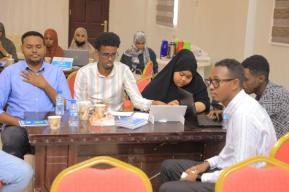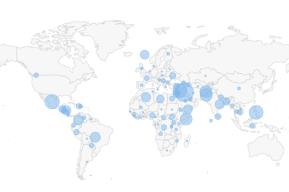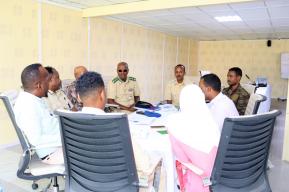News
Cartooning for Peace and Good Governance

The Somali culture is often described as an oral one and adult literacy remains low at about 30% of the population. However, they are a visually literate people and many shops and businesses throughout the country display their full inventory of stocks and services in painted images on shop and building fronts. Communicating using images is therefore second nature. Shopfronts and posters in the dental surgeries and health clinics all around Mogadishu, for example, attest to the richness of this visual culture.
I now understand what cartooning is and how I can use it … like my voice.
CFP, created in 2006 by Kofi Annan and French editorial cartoonist Jean Plantureux (Plantu), is an international network of cartoonists committed to promoting freedom of expression, human rights, and mutual respect amongst people of different cultures and beliefs through the universal language of editorial cartoons. Their mission is not so much to teach cartooning, but to use cartoons to communicate messages of peace while improving participants’ ability to read, decode, interrogate, and interpret them.
Participants learned that there is no single true or "correct" meaning behind a cartoon. Rather the process of asking ‘What do I see? What do I understand? And what do I think about it?’ allows an observer to begin decoding the message. At the same time, the realisation that the artist’s intent and an observer’s interpretation can be different, is a starting point for discussion. One CFP cartoonist noted that he sometimes retrospectively observed unexpected elements in his cartoons which he may not have knowingly inserted at the point of creation.

I have learnt that cartoon art is more useful than many other methods in raising awareness, and how to read a cartoon and understand the message in it.
As this year marks the 75th anniversary year of the Universal Declaration of Human Rights ((UDHR)1948), the Declaration was adopted as the theme of the three-day programme. UNESCO staff and co-facilitators assisted participants to identify an Article of the Declaration and create a cartoon to raise awareness about it. Street art, social media, postering and stencilling were all used as tools of cartoon campaigning.
While celebrating the potential for cartoons to promote peace, CFP facilitators and cartoonists also highlighted the challenges of freedom of expression with cartoons. Cartoons—like words—can damage, defame, and injure people, parties and organisations. There are red lines and limitations that require careful consideration even when attempting to spark a debate, assert an opinion, or criticise a point of view.

I now know that I can show people what I mean by drawing a cartoon.
The third day was dedicated entirely to art, drawing and cartooning. After creating and completing their cartoons, participants displayed them in a ‘marketplace’ set-up around the classroom. Participants also enjoyed the opportunity to experiment with lino printmaking on locally-made tote bags. They learned that lino printing was a cheap and easy way to use art for campaigning, communication, and fun.

Participants and organisers considered the workshop a major success. With the momentum generated from this studio, plans for future programmes with participants from further afield are underway, while an exhibition is scheduled to be held later this year.

Thank you UNESCO and CFP for supporting my participation. I am so happy with the program!
Interviews with Participants
Mohamed Da’ud Isse, 25, university student, writer and blogger
"I had no idea how to express messages by cartoons. I can now draw a cartoon and understand their messages."
Kheirta Abdi Aseir, 24, university student, web designer
"Cartoons send a message, and you can express personal feelings in them. My cartoon was of a young woman university graduate with no job prospects."
Sumaya Ali Sheik, 22, makeup artist
"Cartoons were useless to me but after this studio I can read and understand the message behind them. I would love to go to art school one day. I would like to work in a charity organisation for non-educated people to be educated."
Mohamed Alisalad Mohamud, 24, Civil Engineering student, artist, photographer
"I am drawing cartoons for the first time – it was on gender equity. I thought cartoons were just to laugh at, or for children only, but after this studio I found out that you can use them to communicate with people and voice your thoughts [...] It was a wonderful program; we learned a lot, and it was also a pleasure to meet you. We hope this is not going to end here."
UNESCO is mandated to protect and promote freedom of expression, both online and offline. Its Constitution calls on Member States to advance mutual knowledge and understanding between peoples through the “free flow of ideas by word and image.” For more information, visit:







